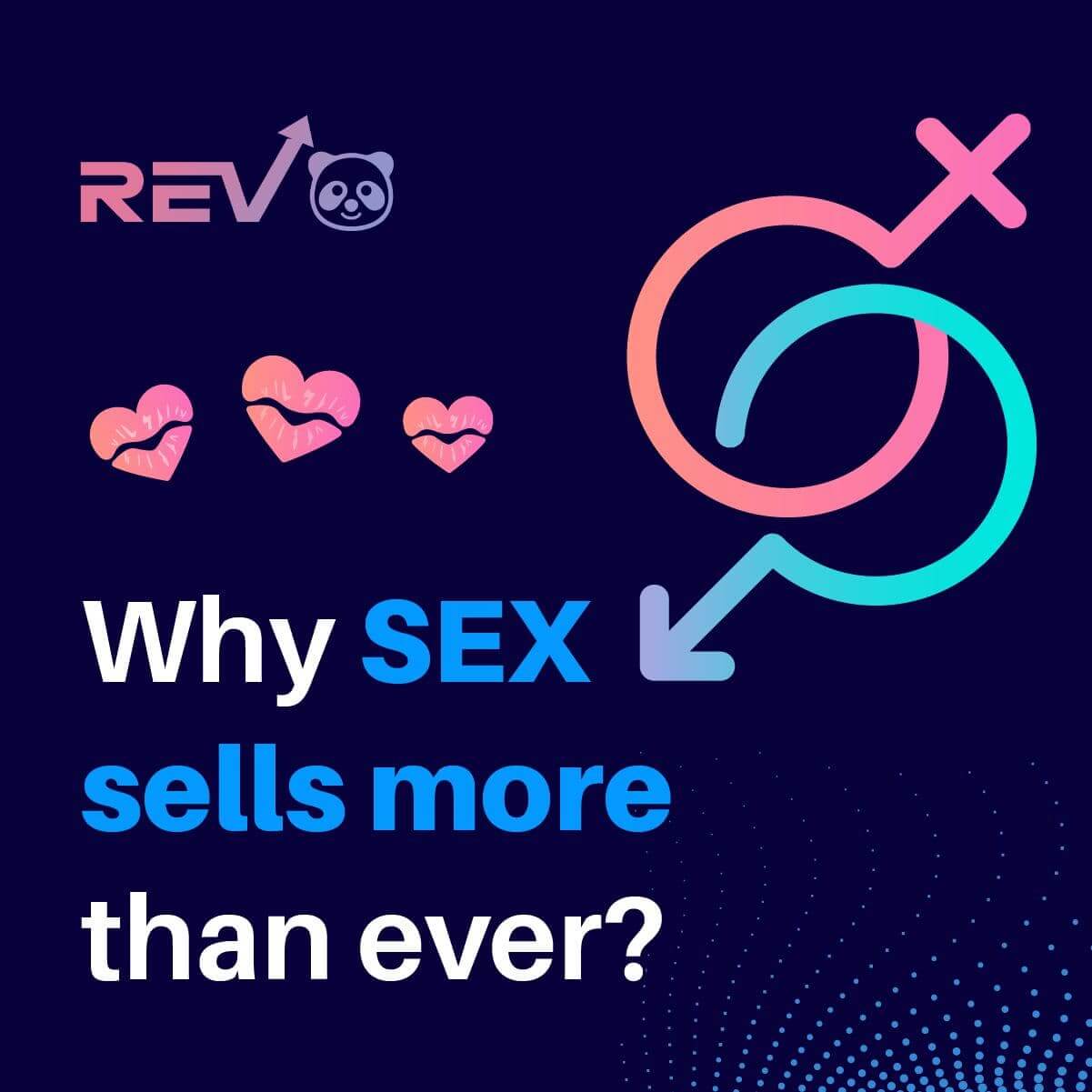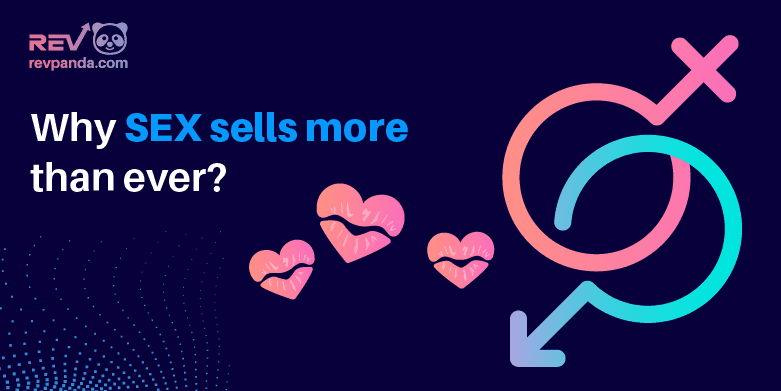
post
Why Sex Sells More than Ever

Table of contents
Click on a title to jump to a section
With time, its use has been adapting to the changes in society, allowing advertisers to promote diverse products through sexual imagery. Although the use of sexy advertisement may seem risky, studies on the subject show the strategy actually works.
According to Prof. Tom Reichert, advertisers use sex because it attracts attention and can be very effective. Sex appeals to basic primal instincts. Besides food and other survival needs, sex appeal has self-preservation interests in humans.
Because of its sensual pleasure, the use of sex in advertising transcends the physical context. Therefore, it is no surprise that advertisers consider sexual imagery to be a powerful tool and have been using it for a long time.
Considering all these, advertisers capitalize on this innate human disposition to promote and sell products.
The Onset of Sex in Sales

Wherever possible, brands will do everything to make their products appear “attractive.” Although some advertisers have been abusing this concept, there is no denying that sex sells. Unlike in the past, to grab the attention of a customer and arouse them requires a lot of explicitness today.
During the early 1900s, just exposing the ankles and arms of female models was enough. However, to achieve the same effect today, it requires the models to be partially nude. As a result of the rise of sexually explicit content in movies, books, television, and social media, besides advertising.
Importance of sex in ads
Humans are hardwired to recognize sexually relevant information, which makes sexually appealing ads easy to spot. Images in advertising shape brand impressions. Although Victoria’s Secret and Calvin Klein may not be very different from Hanes or Vassarette, they are perceived as ‘sexy.’
The number of advertisements featured in the media has been increasing, especially for the sexy industries. Although a taboo subject, using sex in marketing usually creates memorable and effective campaigns.
Brands like GoDaddy.com and Victoria’s Secret came up with ads that do not necessarily talk about their products. Rather, they use sex appeal to attract the viewers’ attention. Grabbing the attention of a potential buyer is half the battle in sales.
These advertisements are great for promoting impulse purchases.
Which Companies Use Sex in Their Ads?
To identify this, we must determine exactly what industries use sex in their advertising campaigns. Almost all sorts of companies incorporate sex in their ads. Some rely on erotic imagery to highlight a product such as underwear and lingerie, while others may use sexual imagery to discuss medical products such as condoms and prescription medication.
Besides, other companies rely on sex to capture the attention of viewers. For instance, Hardee’s ad featuring Kate Upton eating a cheeseburger seductively. Although it gained publicity, people found the approach to be not related to the quality of the cheeseburger.
Marketers even use sex to sell everything from banking services to alcohol. The ads depend on the type of clothing and physical contact between models. The widespread adoption of sexual imagery in ads contributes to the continued use of this approach.
Much of the increase is attributed to ads in specific categories like beauty, alcohol, and entertainment. Also, the use of provocative ads is common in other categories such as clothing, travel, drugs & medicine, and health & hygiene.
How to Include Sex in Advertising
Marketers rely on various methods to include sex in their ads. For example, Old Spice’s body wash ad and Axe’s deodorant ad used different approaches. The bottom line is that these products supposedly make men more desirable in the ads. But how is sex used in advertising & sales exactly? Frankly, there are too many samples to include.
Usually, in perfume ads, only the most beautiful women use the perfume. This insinuates that using that particular perfume will make the user beautiful too.
On the other hand, to sell magazines, sex is used by featuring the “sexiest men alive.” A good example is Sports Illustrated selling a year subscription to a lot of customers who only fancy the swimsuit edition. Often, women are used to pitching sex when selling merchandise and brands.
Apart from entertainment ads, women overwhelmingly feature in sexual advertising. Also, female models are often featured in ads compared to their male counterparts. The upward trend in sexual imagery ads reflects society.
Why Sex Sells in Advertising
Although humans do not walk around thinking about who to fornicate with, quite frankly, they crave sex. A study in The Journal of Sex Research gave some interesting statistics. It was found that men and women think about sex. Men think about sex 19 times a day, while women think of it 10 times a day.
Whichever way you look at it, 10 to 19 times a day is significant and would surely tickle any advertiser. Also, a study in 2012 reported 92% of songs featured on the Billboard’s Top 10 included sexual references. One way to look at it besides the songs being hit songs is that sex sells.
Apart from attracting and retaining the attention of the viewer for a long time, sex in ads has 2 more roles:
- Improving recall of advertising messages
- Evoking emotional responses like lust and arousal.
The bottom line is sex sells in advertising and will continue to sell. However, there is a correct and a wrong way of combining sexuality and advertising. As well, some products pair well with sexual imagery in marketing, and others not so much.
Effectiveness of Using this Marketing Strategy
In every marketing strategy, context matters. And when done in the correct way, it is pretty easy to sell with sexual ads. However, no one likes to be depicted as an object. The same holds for using sexual content in ads. Although it is useful for grabbing attention, it by no means guarantees people will like what they see.
So, sex is used selectively like other advertising tools to target the right audience with the right context. This is a sure way of succeeding in attracting the interest of customers. Research shows sex still is great for brand advertisements that focus on sex-related products.
Examples of Good Use of Sexual Ads
The goal of this provocative approach is to sell more products. However, tracking down examples of ads that incorporate sex well is frustrating. One example is men’s magazines that sell more when using sexy ladies on the front covers instead of male stars.
Generally, a viewer is likely to spend more time looking at the ad if it is sexually appealing. This results in more purchases.
1. Hot Tub
This 2010 ad for Motorola features Meghan Fox in a bathtub taking a picture of herself then sharing it online, causing chaos across the world. The hot Megan shows it is possible to take and share photos online.
2. Carl’s Junior
A 2015 super-sexy Super Bowl Commercial from Carl’s Jr. attracted attention because of featuring a scantly dressed model. The ad features a buxom woman feasting on a hamburger and attracting attention. It is not clear what the ad is about until the 28th second of the 42-second long commercial. The ad is about the new all-natural burger from Carl’s Jr. fast-food company.
3. Skechers
In 2011, Skechers fronted Kim Kardashian as their model in trying to attract a younger audience to try their shoes during the Super Bowl. The steamy ad shows a lot of kin. In this ad, Kim challenges people to ditch bad habits while bringing their friends on board. The ad depicts Sketchers Shake-ups as capable of toning her legs without going to the gym.
Examples of Unsuccessful Use of Sexual Ads
A recent review of stereotypes in ads by the Advertising Standards Authority (ASA) in the UK found that there are harmful stereotypes. And some ads can reinforce the stereotypes that restrict the aspirations and opportunities of young people and adults.
1. Sony: Controversial sexist PlayStation Vita ad
The attempt by Sony to promote its Playstation Vita was downright embarrassing. In this commercial, a female doctor is depicted accusing viewers of spending a lot of time masturbating. The sexist nature of the ad was so blatant the company ended up pulling it down from its YouTube feed.
2. Dolce & Gabbana: The submissive woman

3. Crazy Domains
An advert for Crazy Domains, an internet company, featuring Pamela Anderson, was banned in Australia for being too hot for TV. The commercial starts innocently with the model dressed like a smart corporate businesswoman leading a meeting on internet development.
However, things take a wrong turn when the assistant gives her cream for her coffee. A fellow businessman in the meeting starts fantasizing about the model stripped down to a bikini with a male colleague pouring milk all over her. Then follows gratuitous shots of bums and booms.
Sexy ads may appeal to certain demographics, but most people today are not buying them. However, brands bent on using sex appeal in advertising ensure their strategy is solid and not sexist.
Issues Associated with this Marketing Approach
Society considers sex to be somewhat naughty and taboo. Although it has been used to market many products, a few things are now emerging:
- It cannot sell everything – A relevant context is necessary.
- People are now talking about sex – The use of women bodies as objects to sell products is clear and is turning some people off.
Humans are intelligent and will soon discover manipulation through these ads. Especially when exploiting a woman’s body. Brands often cross the fine line that exists when using sexuality in ads. Sometimes, marketing uses the female body in their marketing campaign.
Over time, the objectification of women’s bodies has been causing negative attitudes and responses.
Appeal, decency, and cultural aspects
Marketers in different countries use the sex sells approach in all manner of ways. Their approaches differ in terms of gender roles as well as consumer attitudes towards sex. However, the common theme is to attract attention using sexual content and models.
Advertisers use sex to target young audiences through sexual appeal as a way to make young adults purchase products. The impact of sexual content in advertising is high on young adults since their sexual expressions are relatively new.
Get Professional Help on Writing Quality Ads
If you need help to grow your business, the one thing you need most is to attract more traffic. The fastest way of achieving this is through advertising. Even tiny changes to your ad response rate by consumers can result in massive improvements in profitability.
With professional help from our digital marketing agency, you have the best chance of creating a persuasive ad copy that can push both consumers and sales. For quality ad copy, contact us.


